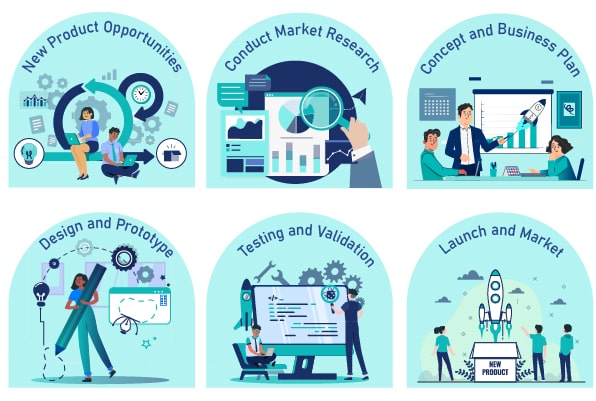New product development is an essential process for businesses looking to stay competitive in today’s dynamic market. It involves the creation, design, and introduction of new products or services that meet the changing needs and preferences of consumers. The process encompasses various stages, including idea generation, concept development, market research, product design, testing, and launch.
Effective new product development requires a deep understanding of customer demands, market trends, and technological advancements. By successfully bringing innovative products to market, businesses can drive growth, attract new customers, and maintain a competitive edge.
This blog takes you through some of the important pointers of new product development process and its execution.
Importance of New Product Development

New product development helps businesses stay ahead of the competition by developing innovative products. With the development of new products and services companies separate themselves from competitors and gain new consumers by incorporating new features in their products and services. Also, new product development can assist businesses in increasing their market share and revenue.
Furthermore, new product development is critical for keeping up with the ever-changing needs and preferences of consumers. Businesses can stay ahead of the newest trends and technology by constantly inventing new products that fit the demands of their customers. Additionally, new product development might result in cost savings and increased productivity. Companies can simplify their operations and cut expenses by introducing new products and services. This can make them more competitive in the market and boost their profit margins.
Navigating the New Product Development Process
New product development is critical for every business that wants to stay competitive and thrive. The procedure might be complicated and intimidating, but by breaking it down into phases, a business can improve its odds of success.

Identify and Evaluate New Product Opportunities:
The first phase in the new product development process is to discover possible new product or service possibilities. This can be accomplished by examining market trends, customer needs, and organizational capabilities. Once possible prospects have been discovered, it must be analyzed to establish its viability.
Conduct Market Research:
This phase includes performing market research to obtain a better knowledge of the target market’s needs, preferences, and purchasing behaviors. This data should be utilized to drive the development of the new product and to design an effective marketing strategy.
Develop a Product Concept and Business Plan:
The next step is to create a product concept and business plan once the market and client demands have been well understood. A full description of the product or service, its characteristics and advantages, and a preliminary design should be included in the proposed product. A marketing strategy, production, distribution plans, and financial estimates should be included in the company plan.
Design and Prototype:
After the product concept and business strategy have been formed, the design and prototype process begins. This is the stage at which the product is brought to life via meticulous design and engineering. A product prototype is developed to evaluate its functionality and collect feedback from potential customers.
Testing and Validation:
The prototype is then tested to confirm that it satisfies all of the required safety, quality, and performance standards. The results of these tests are utilized to make any required changes to the product before it is ready for mass production.
Launch and Market:
Following the validation of the product, it is time to launch and advertise it to the target audience. This involves preparing marketing communications, formulating a launch plan, and initiating a promotional campaign.
Manage the Life Cycle:
The final stage is to manage the product throughout its life cycle, which includes monitoring sales, responding to consumer input, and making any required product or marketing plan changes.
A Few Innovative Examples
Let’s understand how companies successfully navigated to bring new and innovative products to the market.
Some examples of innovative new products and their development processes include:
- The debut of the Tesla Model S electric vehicle transformed the automobile industry with its innovative technology and environmentally friendly design. The Model S’s success was largely due to the company’s emphasis on research and development, as well as its distinct approach to design and engineering.
- The design and commercialization of the Nest thermostat, which launched a new category of smart home gadgets. Nest’s emphasis on simplicity, design and a user-centered approach was critical in the product’s creation and success.
Future Prospects
Staying ahead of the competition is the key to the future of new product development. Companies must continue to innovate and adapt as the business landscape transforms in order to remain relevant and successful. Staying on top of industry trends and recognizing new chances for growth is one method to do this. Furthermore, businesses must understand their target market and be able to successfully communicate the value of their products and services to their audience.
Another critical component of staying ahead in the game of new product development is having a robust procedure in place. A well-defined product development process with distinct stages and milestones, as well as proper project management and communication protocols, should be included.
In addition to these conventional methodologies, the incorporation of emerging technologies such as artificial intelligence, big data, and the Internet of Things holds promise for the future of new product creation. Companies can obtain important insights into behavioral patterns, streamline their product development processes, and build more personalized and targeted products and services by employing these technologies.
Conclusion
The new product development process is a pivotal driver of success for businesses aiming to meet evolving consumer needs and stay ahead in the competitive market landscape. Recognizing the importance of introducing innovative products, companies can differentiate themselves, attract new customers, and increase market share and revenue.
Looking to the future, staying ahead requires a commitment to ongoing innovation, understanding market trends, and leveraging emerging technologies like artificial intelligence and big data to enhance the efficiency and personalization of the product development journey. Businesses that apply these ideas will not just survive but prosper in the volatile terrain of new product development.
For more information on how our digital marketing services can greatly benefit your business, please reach out to us at [email protected] or visit our website today!
All images belong to their respective owners. Please email [email protected] if removal is required.




